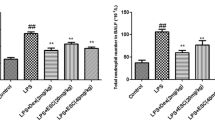Abstract
The present study was designed to investigate the effects of pilose antler peptide (PAP) on lipopolysaccharide (LPS)-induced lung injury. BalB/c mice intraperitoneally received PAP (10 and 20 mg/kg) or dexamethasone (2 mg/kg) 1 h prior to intratracheal instillation of LPS. PAP significantly decreased lung wet-to-dry weight (W/D) ratio and lung myeloperoxidase (MPO) activity and restored LPS-induced lung histopathological changes. PAP also increased super oxide dismutase (SOD) level and inhibited malondialdehyde (MDA) content and levels of pro-inflammatory cytokines including tumor necrosis factor-α (TNF-α), interleukin-1β (IL-1β), and interleukin-6 (IL-6) in bronchoalveolar lavage fluid (BALF) in LPS-stimulated mice. Furthermore, we demonstrated that PAP inhibited Rho/NF-κB pathway in LPS-induced mice. Our experimental results indicated that the protective mechanism of PAP might be attributed partly to the inhibition of Rho/NF-κB pathway.





Similar content being viewed by others
References
Matthay, M.A., L.B. Ware, and G.A. Zimmerman. 2012. The acute respiratory distress syndrome. New England Journal of Medicine 332(14): 27–37.
Elicker, B.M., et al. 2016. Imaging of acute lung injury. Radiologic Clinics of North America.
Kim, Y.K., K.S. Kim, K.H. Chung, J.G. Kim, K.S. Kim, Y.C. Lee, Y.C. Chang, and C.H. Kim. 2003. Inhibitory effects of deer antler aqua-acupuncture, the pilose antler of Cervus korean TEMMINCK var. mantchuricus Swinhoe, on type II collagen-induced arthritis in rats. International Immunopharmacology 3: 1001–1010.
Lin, J.-H., L.-X. Deng, Z.-Y. Wu, L. Chen, and L. Zhang. 2011. Pilose antler polypeptides promote chondrocyte proliferation via the tyrosine kinase signaling pathway. Journal of Occupational Medicine Toxicology 6: 27.
Takikawa, K., N. Kokubu, M. Kajihara, M. Dohi, and N. Tahara. 1972. Studies of experimental Whiplash Injury (III): changes in enzyme activities of cervical cords and effect of Pantui extracts, Pantocrin as a remedy. Folia Pharmacologica Japonica 68: 489–493.
Zhu, L., et al. 2015. Salidroside attenuates lipopolysaccharide(LPS) induced serum cytokines and depressive-like behavior in mice. Neuroscience Letters 606: 1–6.
Lou, T., et al. 2015. Inhibitory effects of polydatin on lipopolysaccharide-stimulated RAW 264.7 cells. Inflammation 38(3): 1–8.
Ghosh, S., et al. 1993. Endotoxin-induced organ injury. Critical Care Medicine 21(2 Suppl): 19–24.
Segain, J.P., et al. 2003. Rho kinase blockade prevents inflammation via nuclear factor kappa B inhibition: evidence in Crohn’s disease and experimental colitis. Gastroenterology 124(5): 1180–1187.
Gibson, C.L., et al. 2014. Inhibition of Rho-kinase protects cerebral barrier from ischaemia-evoked injury through modulations of endothelial cell oxidative stress and tight junctions. Journal of Neurochemistry 129(5): 816–826.
Ishikura, K., et al. 2006. Beneficial acute effects of rho-kinase inhibitor in patients with pulmonary arterial hypertension. Circulation Journal 70(2): 174–178.
Zhou, F., et al. 2016. Liraglutide attenuates lipopolysaccharide-induced acute lung injury in mice. European Journal of Pharmacology 791: 735–740.
Kellner, P., et al. 2016. Sevoflurane abolishes oxygenation impairment in a long-term rat model of acute lung injury. Anesthesia and Analgesia.
Li, C., et al. 2016. NFAT5 participates in seawater inhalation-induced acute lung injury via modulation of NF-kappaB activity. Molecular Medicine Reports.
Jang, Y.J., et al. 2016. Protective effect of sesquiterpene lactone parthenolide on LPS-induced acute lung injury. Archives of Pharmacal Research.
Yang, S., et al. 2016. Therapeutic effect of methyl salicylate 2-O-beta-d-lactoside on LPS-induced acute lung injury by inhibiting TAK1/NF-kappaB phosphorylation and NLRP3 expression. International Immunopharmacology 40: 219–228.
Jiang, W., et al. 2016. Protective effects of asiatic acid against spinal cord injury-induced acute lung injury in rats. Inflammation.
Diao, M., et al. 2016. Hydrogen gas inhalation attenuates seawater instillation-induced acute lung injury via the Nrf2 pathway in rabbits.
Wang, G., et al. 2016. Activation of AMPK attenuates LPS-induced acute lung injury by upregulation of PGC1alpha and SOD1. Experimental and Therapeutic Medicine 12(3): 1551–1555.
Zhao, J., et al. 2016. Protective effect of suppressing STAT3 activity in LPS-induced acute lung injury. 311(5): p. L868-l880.
Matsuishi, Y., et al. 2016. Landiolol hydrochloride ameliorates acute lung injury in a rat model of early sepsis through the suppression of elevated levels of pulmonary endothelin-1. Life Sciences.
Liu, T.Y., and S.B. Chen. 2016. Sarcandra glabra combined with lycopene protect rats from lipopolysaccharide induced acute lung injury via reducing inflammatory response. Biomedicine and Pharmacotherapy 84: 34–41.
Zhe, Q., et al. 2016. Effects of Jiaotaiwan on depressive-like behavior in mice after lipopolysaccharide administration. Metabolic Brain Disease.
Mishra, R.K., et al. 2016. c-Jun is required for nuclear factor-kappaB-dependent, LPS-stimulated fos-related antigen-1 transcription in alveolar macrophages. American Journal of Respiratory Cell and Molecular Biology 55(5): 667–674.
Courtois, G., and T.D. Gilmore. 2006. Mutations in the NF-kappaB signaling pathway: implications for human disease. Oncogene 25(51): 6831–6843.
von Bernuth, H., et al. 2005. Septicemia without sepsis: inherited disorders of nuclear factor-kappa B-mediated inflammation. Clinical Infectious Diseases 41(Suppl 7): S436–S439.
Pranatharthi, A., C. Ross, and S. Srivastava. 2016. Cancer stem cells and radioresistance: Rho/ROCK pathway plea attention. 2016: p. 5785786.
Du, L., et al. 2016. Crosstalk between inflammation and ROCK/MLCK signaling pathways in gastrointestinal disorders with intestinal hyperpermeability. 2016: p. 7374197.
Author information
Authors and Affiliations
Corresponding authors
Rights and permissions
About this article
Cite this article
Ma, C., Long, H., Yang, C. et al. Anti-inflammatory Role of Pilose Antler Peptide in LPS-Induced Lung Injury. Inflammation 40, 904–912 (2017). https://doi.org/10.1007/s10753-017-0535-3
Published:
Issue Date:
DOI: https://doi.org/10.1007/s10753-017-0535-3




